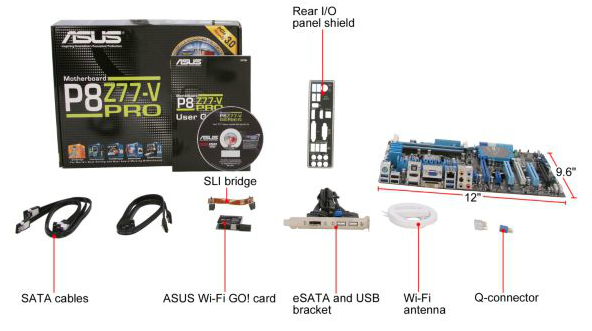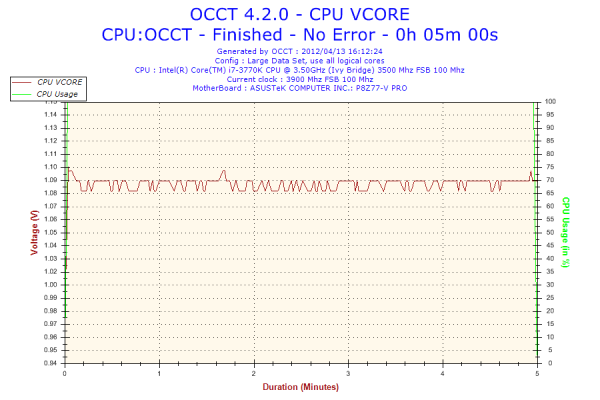Intel Z77 Motherboard Review with Ivy Bridge - ASRock, ASUS, Gigabyte, and MSI
by Ian Cutress on May 7, 2012 7:40 PM EST- Posted in
- Motherboards
- MSI
- Gigabyte
- ASRock
- Asus
- Ivy Bridge
- Z77
ASUS P8Z77-V Pro - In The Box
The ASUS P8Z77-V Pro retails at $225-$235, essentially $100 more than the ASRock Z77 Extreme4, so I would expect a good amount in the box to help sweeten the price point. Thankfully, we get a good amount!
Driver CD
User Manual
IO Panel
4 SATA Cables
SLI Finger
WiFi Go! 802.11 a/b/g/n WiFi card
WiFi magnetic antenna
USB and eSATA back panel
ASUS Q-Connectors

The addition of WiFi on the board obviously adds substantial value – personally, at home, I have my machines connected via WiFi, and ASUS say that at least 25% of their user base is in a similar position, hence the addition to the package.
Voltage Readings
Using OCCT we monitor the voltage change of the motherboard under load. This represents the direct correlation between the Load Line Calibration and how the processor/motherboard deals with voltage requests while under load. This is not to be confused with the quality of power delivery, but more an indication of how aggressive the default LLC settings are on a motherboard.
The ASUS board has regular power delivery, with minimal voltage ripple under load.
Overclocking
Note: Ivy Bridge does not overclock like Sandy Bridge. For a detailed report on the effect of voltage on Ivy Bridge (and thus temperatures and power draw), please read Undervolting and Overclocking on Ivy Bridge.
ASUS overclocking tools have been consistent over the few previous chipsets. In the BIOS, OC Tuner is a simple setting that enables a ‘Fast’ overclock on the system. Similarly, the TPU button on board does a similar action. In the OS, the TurboV Evo part of the software offers ‘Fast’ and ‘Extreme’ auto overclocking modes. For manual overclocking, the TurboV Evo software allows the user to play with an overclock in the OS, which should aid in setting a more permanent overclock in the BIOS.
Auto Overclock: ‘Fast’ mode (either through BIOS or OS) implements an immediate 19% overclock, with 41x on the multiplier and 102 MHz base frequency, ending with 4182 MHz overall. This is coupled with a memory overclock, which in my case it did XMP but backed off one memory strap. What was odd was that the memory was set to a 3T command rate!
‘Extreme’ mode implements a algorithmic testing tool in the OS to probe overclock limits. By slowly upping the multiplier and voltage, the system performs stability tests until the system crashes. The system reboots and then implements BCLK tuning, while still monitoring temperatures. In our test, the initial boot implemented a 20% overclock at 41x103 (4223 MHz), and then performed multiplier testing. At 47x, the system restarted to 46x and started BCLK tuning. At 104.5 MHz, the system restarted again, do a ‘Failed Overclock’ screen on boot. After pressing F1 for Setup, then F10 for Save and Exit, the operating system showed an overall 36% overclock – 46x103.8 (4774 MHz). At load, this gave 1.280 volts at load, giving an immense 94ºC peak temperature during PovRay. I do not think I would be happy with that temperature for a daily system.
Manual Overclock: With the overclock performance of Ivy Bridge processors being highly limited by temperature, having a low voltage is key along with hope that it does not compromise the overclock. In this case, I have started with 1.100 volts on the CPU and adjusting only the CPU multiplier to see what stable overclock we can get, before upping the voltage further. For this, PLL Overvoltage was also enabled.
At 1.100 volts, the highest multiplier that was stable was 45x, giving 4.5 GHz. This gave 68ºC at load with PovRay.
At 1.150 volts, the highest multiplier that was stable was 46x, giving 4.6 GHz. This gave 76ºC at load with PovRay.
At 1.200 volts, the highest multiplier that was stable was 47x, giving 4.7 GHz. This gave 83ºC with PovRay and 86ºC with OCCT. The system did boot at 48x, but gave 94ºC under PovRay as well as memory errors.










117 Comments
View All Comments
Jase89 - Sunday, May 19, 2013 - link
Having RAID Option ROM Supported in UEFI as well (people using RAID) is a very good thing ASRock have done with their Z77 series, wonder when Gigabyte will add this feature, http://www.youtube.com/watch?v=Y1TbdVtAE9cgramboh - Tuesday, May 8, 2012 - link
Just wanted to add that my new P8Z77-V Pro POSTS significantly faster than what Ian experienced in this review, probably due to my configuration:Intel SATA: AHCI
ASmedia USB3: on
ASmedia SATA controller: off
Wifi: off
Onboard sound: off
My total time from splash screen to Windows 7 Pro x64 login is 15 seconds on a Mushkin Chronos Deluxe 240GB. The post is about 6 seconds (hand timing these). It's unfortunately the other controllers add ~14 seconds of POST time.
IanCutress - Tuesday, May 8, 2012 - link
Hi Gramboh,Disabling ASMedia SATA, Wifi and Sound would obviously decrease POST time by quite a bit! As I doubt the majority of non-enthusiast buyers would go into the BIOS and disable what they don't need, I kept the start up sequence the same as default to reflect this.
Ian
DanNeely - Tuesday, May 8, 2012 - link
A large number of your readers are enthusiasts. Giving both sets of numbers would be beneficial for us. A per onboard device breakdown of boot time would be nice; but probably too much work to be justified.IanCutress - Tuesday, May 8, 2012 - link
I've added 'POST Quick' to my internal database of testing, with the aim to turn off all I can to observe POST times. Will be applied from the next review onwards, perhaps retroactively if I get time.Ian
AlexIsAlex - Wednesday, May 9, 2012 - link
Awesome, thank you so much!Perhaps the manufacturers will pay attention to this too :-)
Paapaa125 - Wednesday, May 9, 2012 - link
I think most Anandtech readers DO go to BIOS to set things up. I think it is crucial to know if the differences in performance (boot time, benchmarks, power consumption etc) can be minimized just by changing BIOS settings. That would make it a lot easier to buy a new board.I have seen reports that some boards don't follow the Intel specs regarding Turbo Boost settings and utilize higher frequency with all cores utilized. This skews the performance results greatly. Those following the specs get worse results - yet they could be configured for exact same performance.
dananski - Tuesday, May 8, 2012 - link
Makes me really glad to have ordered the ASRock, though I wonder how it would be affected by having RAID enabled? My GA-P35C-DS3R takes about a minute to get through POST and RAID screens.I am also confused why even the quick one is taking so long. My laptops take less than 5 secs to POST :/
EnzoFX - Monday, May 7, 2012 - link
ATX just seems like it's for bragging rights, and not even directly so, simply because you'll be able to say you have so many things connected, maybe you even have tri or quad SLI, all in a huge case. Can we get some coverage of mATX boards?On another note, something that drives me nuts is the AHCI driver loading at POST. Last time I checked I couldn't find a straight answer, does this loading stage still happen in ivy bridge? Of course you don't have to use AHCI, but it really should be standard and enabled by default. At least for anyone spending this much on a motherboard.
EnzoFX - Monday, May 7, 2012 - link
"Conclusion – Gigabyte MSI Z77A-GD65"One more rant lol. Is having all 4 video outputs really a feature? Is this not targeted at people who will be using their own graphics card? In which case they only serve to use up space that could be used towards USB ports or something else that's almost as useful. Remember before P55, 10 usb ports were starting to be the average on a feature filled board, now we have to settle for 6-8. Unless you want to spend top dollar for more.